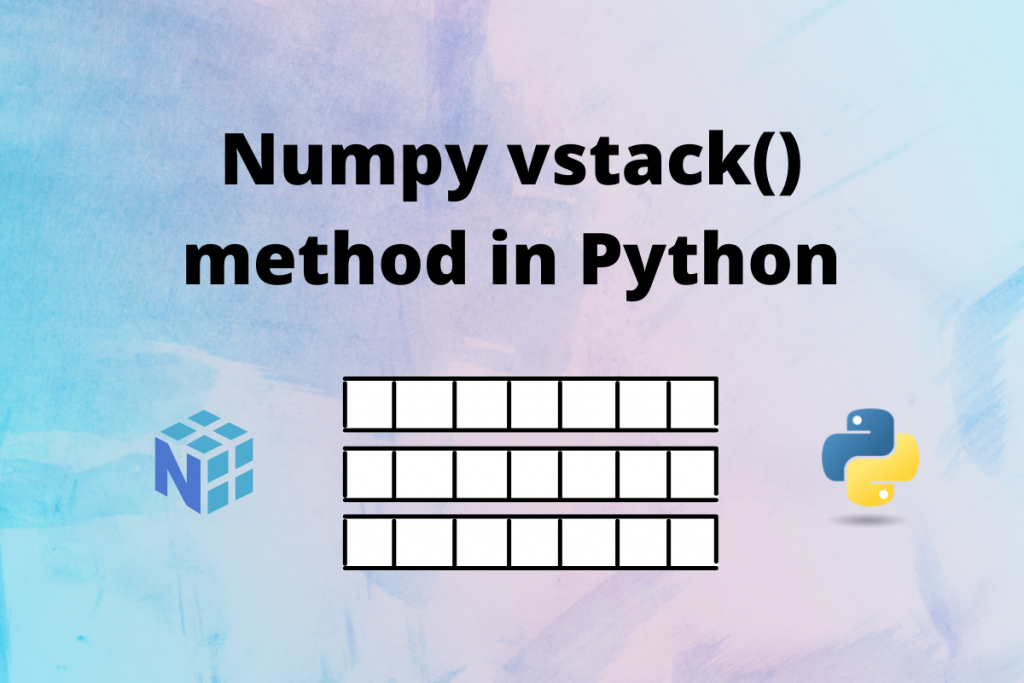Hello everyone! In this tutorial, we will learn what the Numpy vstack() method is and how to use it in Python. So let’s get started.
What is numpy.vstack() method ?
Numpy.vstack() is a function in Python that takes a tuple of arrays and concatenates them vertically along the first dimension to make them a single array.
It’s syntax is:
numpy.vstack(tup)
The parameter it takes is a tuple which is a sequence of ndarrays that we want to concatenate. The arrays must have the same shape along all axis except the first axis.
The method returns a ndarray which is formed by stacking the arrays given in the input. The returned array will have at least 2 dimensions.
Examples of Numpy vstack()
For linear 1-D arrays, all the arrays are stacked vertically to form a 2-D array. All the input arrays must have the same length.
import numpy
a = numpy.array([1, 2, 3, 4, 5])
b = numpy.array([6, 7, 8, 9, 10])
c = numpy.array([11, 12, 13, 14, 15])
print("Shape of array A:", a.shape)
print("Shape of array B:", b.shape)
print("Shape of array C:", c.shape)
print()
stack = numpy.vstack((a, b, c))
print("Shape of new stacked array:", stack.shape)
print("Stacked array is")
print(stack)
Shape of array A: (5,)
Shape of array B: (5,)
Shape of array C: (5,)
Shape of new stacked array: (3, 5)
Stacked array is
[[ 1 2 3 4 5]
[ 6 7 8 9 10]
[11 12 13 14 15]]
For N-dimensional arrays, arrays are stacked along the first dimensions as shown in the following example.
import numpy
a = numpy.array([ [1, 2, 3], [4, 5, 6] ])
b = numpy.array([ [7, 8, 9], [10, 11, 12] ])
print("Shape of array A:", a.shape)
print("Shape of array B:", b.shape)
print()
stack = numpy.vstack((a, b))
print("Shape of new stacked array:", stack.shape)
print("Array is")
print(stack)
Output:
Shape of array A: (2, 3)
Shape of array B: (2, 3)
Shape of new stacked array: (4, 3)
Array is
[[ 1 2 3]
[ 4 5 6]
[ 7 8 9]
[10 11 12]]
For N-dimensional arrays, the shape of the arrays must be the same along all dimensions except the first dimension as shown below.
import numpy
a = numpy.array([ [1, 2], [3, 4] ])
b = numpy.array([ [5, 6], [7, 8], [9, 10] ])
print("Shape of array A:", a.shape)
print("Shape of array B:", b.shape)
print()
stack = numpy.vstack((a, b))
print("Shape of new stacked array:", stack.shape)
print("Array is")
print(stack)
Shape of array A: (2, 2)
Shape of array B: (3, 2)
Shape of new stacked array: (5, 2)
Array is
[[ 1 2]
[ 3 4]
[ 5 6]
[ 7 8]
[ 9 10]]
Conclusion
In this Python tutorial, we learned about vstack() method present in the NumPy module. This function makes most sense for arrays with up to 3 dimensions. For instance, for pixel-data with a height (first axis), width (second axis), and r/g/b channels (third axis).
Thanks for reading!!
